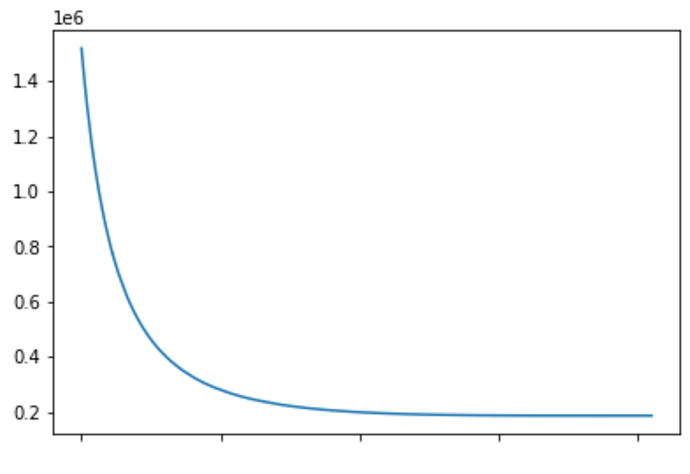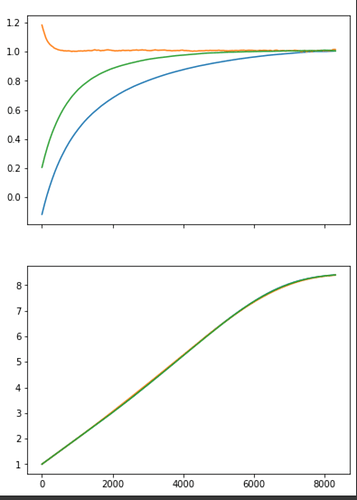I’m creating a simple HMM with gaussian emission. Modified from example from: Example: Hidden Markov Models — Pyro Tutorials 1.8.4 documentation
I got two issues:
sample function always return [0, 1, 2] after first epoch.
parameter p_mu merely change
def model(observations, num_state):
with poutine.mask(mask = True):
p_mu = pyro.sample("p_mu",
dist.Normal(0, 10000).expand([num_state]).to_event(1))
p_tau = pyro.sample("p_tau",
dist.Exponential(1).expand([num_state]).to_event(1))
p_transition = pyro.sample("p_transition",
dist.Dirichlet((1 / num_state) * torch.ones(num_state, num_state)).to_event(1))
current_state = 0
counter = 0
for t in pyro.markov(range(len(observations))):
counter += 1
current_state = pyro.sample("x_{}".format(t),
dist.Categorical(Vindex(p_transition)[current_state]),
infer = {"enumerate" : "parallel"})
print("counter: " + str(counter))
print(current_state)
pyro.sample("y_{}".format(t),
dist.Normal(Vindex(p_mu)[...,current_state], Vindex(p_tau)[...,current_state]),
obs = observations[t])
I use TraceTMC_ELBO
counter: 198
tensor(0)
counter: 199
tensor(1)
counter: 200
tensor(0)
counter: 1
tensor([[0],
[1],
[2]])
counter: 2
tensor([[[0]],
[[1]],
[[2]]])
counter: 3
tensor([[0],
[1],
[2]])
counter: 4
tensor([[[0]],
[[1]],
[[2]]])
fritzo
August 24, 2022, 1:13pm
2
The first issue is due to enumeration. Actually the [[0],[1],[2]] shapes are returned every iteration. What you’re seeing first is a trial run of the guide to determine shapes. For explanation see the Tensor shapes tutorial .
So is it proper for my model? Since I expect to only sample one number at a time.
fritzo
August 30, 2022, 6:09pm
4
Yes, these tensor shapes are expected and proper. Each of Pyro’s inference algorithms evaluates your model in a different nonstandard interpretation . Trace_ELBO is straightforward and simply evaluates with differentiable PyTorch tensors; TraceEnum_ELBO evaluates with specially shaped tensors that enumerate discrete values over all possible values, then later marginalize out those values; TraceTMC_ELBO evaluates with batches of samples at each site. These nonstandard evaluations enable inference.
Thanks for replying. I changed the ELBO for my HMM into Trace_ELBO, and something very wired happened.
Here’s my current model.
def model(observations, num_state):
assert not torch._C._get_tracing_state()
with poutine.mask(mask = True):
p_transition = pyro.sample("p_transition",
dist.Dirichlet((1 / num_state) * torch.ones(num_state, num_state)).to_event(1))
p_mu = pyro.param(name = "p_mu",
init_tensor = torch.randn(num_state),
constraint = constraints.real)
p_tau = pyro.param(name = "p_tau",
init_tensor = torch.ones(num_state),
constraint = constraints.positive)
current_state = 0
with pyro.plate('obs_plate', len(obs)):
for t in pyro.markov(range(len(observations))):
current_state = pyro.sample("x_{}".format(t),
dist.Categorical(Vindex(p_transition)[current_state, :]),
infer = {"enumerate" : "parallel"})
pyro.sample("y_{}".format(t),
dist.Normal(Vindex(p_mu)[current_state], Vindex(p_tau)[current_state]),
obs = observations[t])
I fit it by
device = torch.device("cuda:0")
obs = torch.tensor(obs)
obs = obs.to(device)
torch.set_default_tensor_type("torch.cuda.FloatTensor")
guide = AutoDelta(poutine.block(model, expose_fn = lambda msg : msg["name"].startswith("p_")))
Elbo = Trace_ELBO
elbo = Elbo(max_plate_nesting = 1)
optim = Adam({"lr": 0.001})
svi = SVI(model, guide, optim, elbo)
while 1:
loss = svi.step(observations = obs, num_state = 3)
The true value of my parameter mu are [-10, 1, 10]
But as the model trains, the ELBO is
mu and sigma looks like:
Do you have any thoughts about how I could fix the problem?

